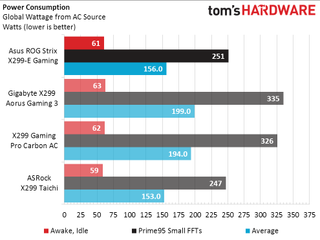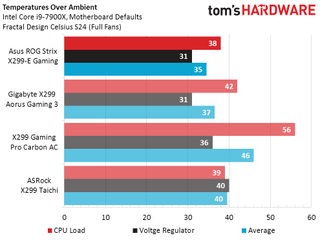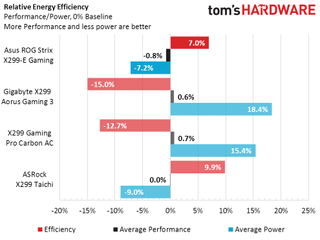Asus ROG Strix X299-E Gaming ATX Motherboard Review: 44-Lane CPU Ready
Why you can trust Tom's Hardware
Benchmark Results & Final Analysis
Synthetic Benchmarks
Boring synthetic benchmarks are the best indication that nobody is cheating, and we’re happy to say that the Strix X299-E Gaming’s edge in 3DMark is too slight to prompt an investigation.






Sandra Arithmetic is the best indication that none of the comparison motherboards has noticeably overclocked the CPU. One of the competing boards had an odd result in Sandra Multimedia, but that difference didn’t show up elsewhere.




Sandra Cryptography typically favors more memory bandwidth, and the tightening of advanced memory timings is one place where we haven’t really focused on vendor-specific optimizations even though the competing MSI motherboard’s bandwidth lead is somewhat compelling. The Strix X299-E Gaming performed slightly better than average in two Compubench GPU-accelerated metrics, but competitors edged it out in two others.
3D Games




The Strix X299-E Gaming hit a nearly perfect average in gaming performance, whereas a couple competitors were hit or miss. The X299 Gaming Pro Carbon AC, for example, has a premium audio software program that, when enabled, forces it to lose around 32 percent of its Talos performance. That’s because Talos is the only program compatible with that software, and enabling its features adds overhead (hollow bars show that board’s performance with the added software disabled).
Timed Applications



The ROG Strix X299-E Gaming stumbled in at least one application of each timed run chart, with noticeably longer completion times for Handbrake, Adobe Illustrator and PowerPoint. So, we changed some settings and retested. Several retests did not reveal the source of the minor setback. We discuss those retests in the Power, Heat & Efficiency section below.
Power, Heat & Efficiency

At default settings, the Strix X299-E Gaming throttled back to 3.40 GHz under the heavy AVX load of Prime95 small FFTs, saving 33W compared to the charted value. Changing its Long Duration and Short Duration firmware power settings to their maximums allowed it to run that test at 3.60 GHz, bringing it to par with the X299 Taichi and pushing its loaded wattage to 251W. After that, changing its CPU Integrated VR Current Limit firmware value to its maximum value allowed the board to run Prime95 small-FFTs at 4.00 GHz while consuming 326W. We ran our benchmarks three ways and determined that those applications weren’t stressful enough to produce noticeably different encoding times or frame rates. Since 11 of the 16 X299 boards we’ve reviewed consumed around 250W and ran at 3.60 GHz at full load, we decided to use this data.

The Strix X299-E Gaming runs a little cooler than its closest competitors, beating even the lower-powered X299 Taichi.

We looked at more than just the four boards presented in our small charts. We’re using all 16 previously reviewed boards in our overall performance and power calculations. It took a few small hits in our productivity benchmarks, but the Strix X299-E Gaming came out a mere 0.8 percent below the average of every X299 board we’ve tested in performance and produced a seven percent above-average efficiency number
Overclocking

Though a few of our four-module boards have pushed our memory past DDR4-4000, the Strix X299-E Gaming’s DDR4-3912 is a very respectable overclock compared to other eight-DIMM boards. Its 4.40 GHz CPU overclock is less noteworthy since 14 of the previous 16 boards have reached that limit, and it’s still better than the 4.5 to 4.8 GHz reported by people who don’t run 20 threads of Prime95 small-FFTs. When we say full load, we mean it!

The point of overclocking memory is to get more performance, and the Strix X299-E Gaming did that spectacularly as seen in the above chart. On the other hand, we’ve seen similar results from half of the last 16 boards we've tested. As usual, price similarity is the factor that limits the range shown in our comparison chart.
Final Analysis
The Asus ROG Strix X299-E Gaming is slightly cheaper than Gigabyte’s X299 Aorus Gaming 3 and slightly more expensive than the other two boards in our comparison chart. That price-to-performance comparison isn’t adjusted for features, however.

It’s impossible to run 3-way SLI on a 16-lane CPU, but if you’re a buyer hoping to do so on a 28-lane CPU, you can cross the Strix X299-E Gaming (and X299 Aorus Gaming 3) off your list. The same factors apply to the use of the third slot to host a PCIe x8 NVMe drive adapter to that third PCIe x16 slot, so it’s not just people running outdated graphics configuration who’ve been impacted by these design decisions. Ouch.
Builders who purchase a case with a 10Gb/s Type-C connector will want an interface for the Gen3.1 front-panel cable, and they’ll only get that from the Strix X299-E Gaming or the MSI X299 Gaming Pro Carbon AC. Those boards are also the only ones in the compared price range to include an 867Mb/s Wi-Fi solution.
A look at the complete features list shows that the X299 Gaming Pro Carbon AC does nearly everything for $20 less than the Strix X299-E Gaming, yet builders of show PCs will note that Asus’s ROG light box logo looks great and that its lighting software is universally recognized for ultimate stability and compatibility. The Strix X299-E Gaming also runs cooler and edged out the MSI board in our overclocking chart. Since buyers of 44-lane processors need not worry about the limitations of the Strix X299-E Gaming’s slot configuration, it’s at least worthy of their consideration.
MORE: Best Motherboards
MORE: How To Choose A Motherboard
MORE: All Motherboard Content
Stay on the Cutting Edge
Join the experts who read Tom's Hardware for the inside track on enthusiast PC tech news — and have for over 25 years. We'll send breaking news and in-depth reviews of CPUs, GPUs, AI, maker hardware and more straight to your inbox.
-
newsonline5000000 Actually we need Three x8 Slots not for three ways SLI , but for 2 x SLI AND an x8 Card (NVME cards or Raid cards)Reply
you need to stop focusing on SLI and think about more cards to add. With today GPU power , we dont need more than Two GPUs of High end cards. -
derekullo Reply21206294 said:Actually we need Three x8 Slots not for three ways SLI , but for 2 x SLI AND an x8 Card (NVME cards or Raid cards)
you need to stop focusing on SLI and think about more cards to add. With today GPU power , we dont need more than Two GPUs of High end cards.
To be fair, Gaming is in the name of the "Asus ROG Strix X299-E Gaming" in regards to SLI.
If you wanted to install a raid or NVME card in this motherboard you very well could.
But this isn't a workstation motherboard and isn't marketed as such.
For your needs you would be much better suited to the ASUS ROG ZENITH EXTREME which supports 4 pci-e slots in a x16/x8/x16/x8 configuration, ECC ram, 3 - m.2 drives and a Threadripper cpu to make all those lanes possible.
-
Crashman Reply
Right, so you put two cards in the first and second slot and a PCIe x8 NVMe adapter with two M.2 drives on the bottom slot. And then you use a 28-lane CPU and find that only 1 of your drives is seen, and only in x1 mode. Same complaint then?21206294 said:Actually we need Three x8 Slots not for three ways SLI , but for 2 x SLI AND an x8 Card (NVME cards or Raid cards)
you need to stop focusing on SLI and think about more cards to add. With today GPU power , we dont need more than Two GPUs of High end cards.
-
papality only 8 phases on the VRMs on a board that needs the highest end x299 processors to be worthwhile? whatReply -
Crashman Reply
8 60's is worth 16 30's? Putting memory on both sides of the processor doesn't leave a great deal of room for extra power components, companies have almost universally went with higher ampacity components for there X299 models instead.21208236 said:only 8 phases on the VRMs on a board that needs the highest end x299 processors to be worthwhile? what
-
robert.sandru Is anyone seriously considering X299 for gaming?Reply
I mean it's a ROG board but as a platform the X299 is pressured on both performance and cost by better Intel and AMD solutions... -
newsonline5000000 Reply21206736 said:
Right, so you put two cards in the first and second slot and a PCIe x8 NVMe adapter with two M.2 drives on the bottom slot. And then you use a 28-lane CPU and find that only 1 of your drives is seen, and only in x1 mode. Same complaint then?21206294 said:Actually we need Three x8 Slots not for three ways SLI , but for 2 x SLI AND an x8 Card (NVME cards or Raid cards)
you need to stop focusing on SLI and think about more cards to add. With today GPU power , we dont need more than Two GPUs of High end cards.
Why not see it if the bios is designed to see the split lanes between three slots ? I dont get your x1 mode at all , and I dont get it why only one SSD will be shown ..
-
Crashman Reply21211737 said:21206736 said:
Right, so you put two cards in the first and second slot and a PCIe x8 NVMe adapter with two M.2 drives on the bottom slot. And then you use a 28-lane CPU and find that only 1 of your drives is seen, and only in x1 mode. Same complaint then?21206294 said:Actually we need Three x8 Slots not for three ways SLI , but for 2 x SLI AND an x8 Card (NVME cards or Raid cards)
you need to stop focusing on SLI and think about more cards to add. With today GPU power , we dont need more than Two GPUs of High end cards.
Why not see it if the bios is designed to see the split lanes between three slots ? I dont get your x1 mode at all , and I dont get it why only one SSD will be shown ..
Per Asus, PCIe x16 slot configuration is:
44-lane CPU: x16/x16/x8
28-lane CPU: x16/x8/x1
16-lane CPU: x16/x0/x1, x8/x8/x1
So there's your x1. Now if you're running a passive x8 adapter card, the first four lanes go to the first M.2 drive, the second four lanes go to the second M.2 drive. But, there's only one lane on the third slot with a 28-lane CPU, so if you put your passive adapter there, the first M.2 drive gets one lane and the second M.2 drive gets no lanes.
